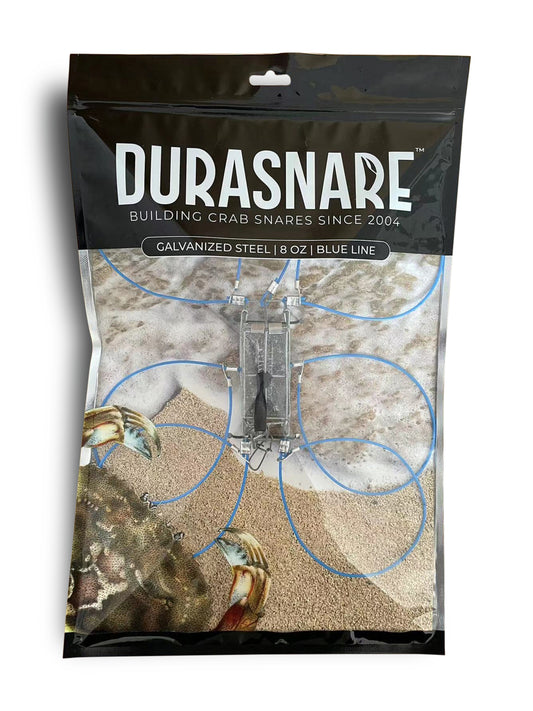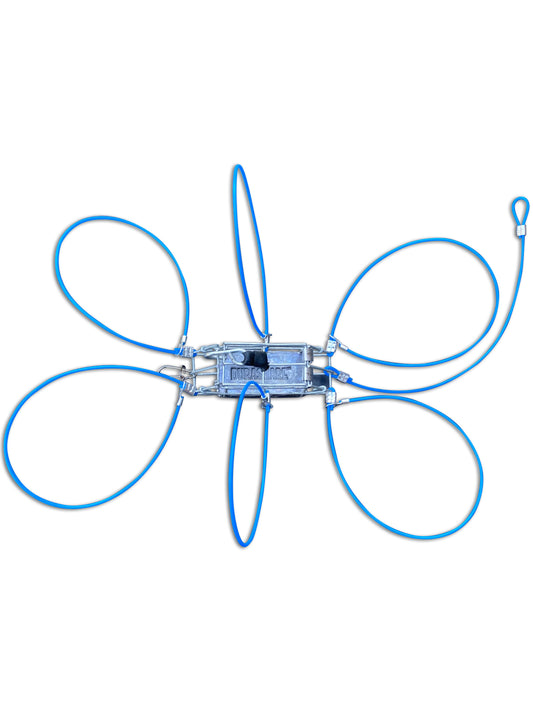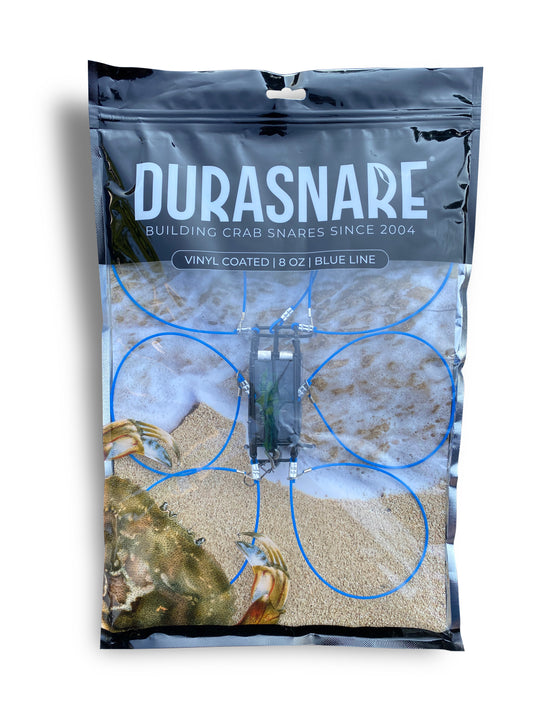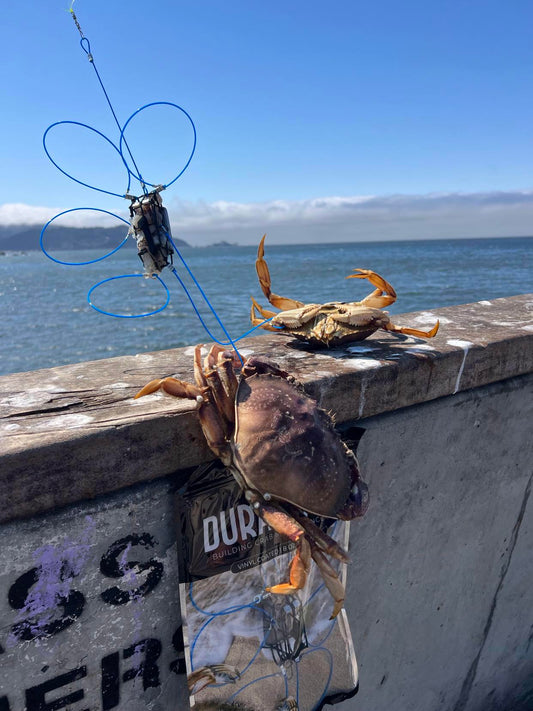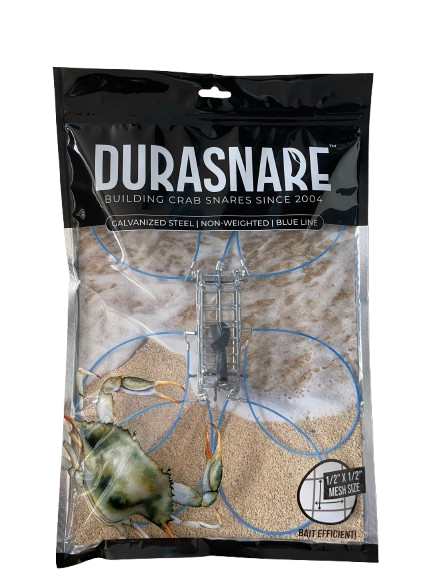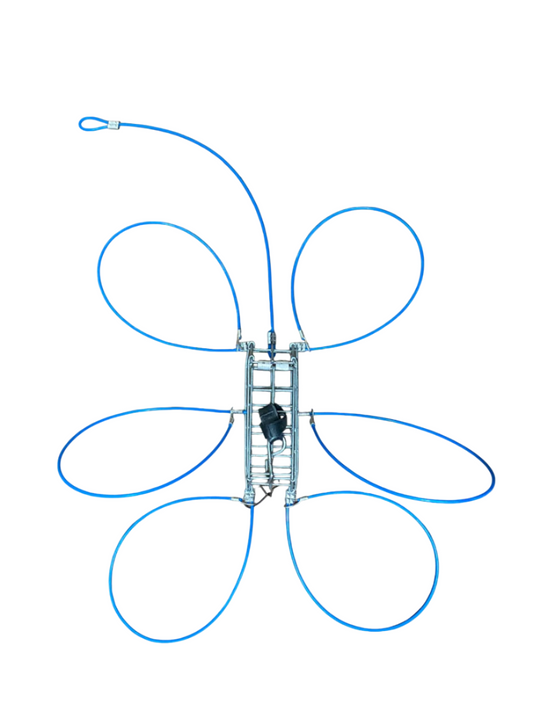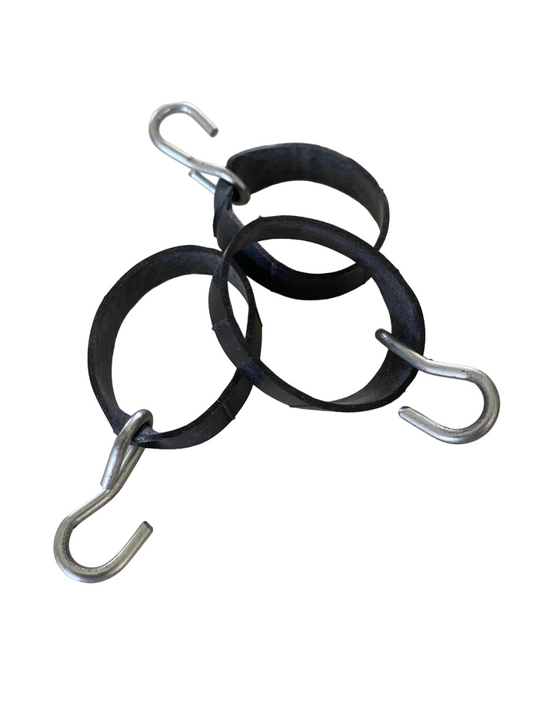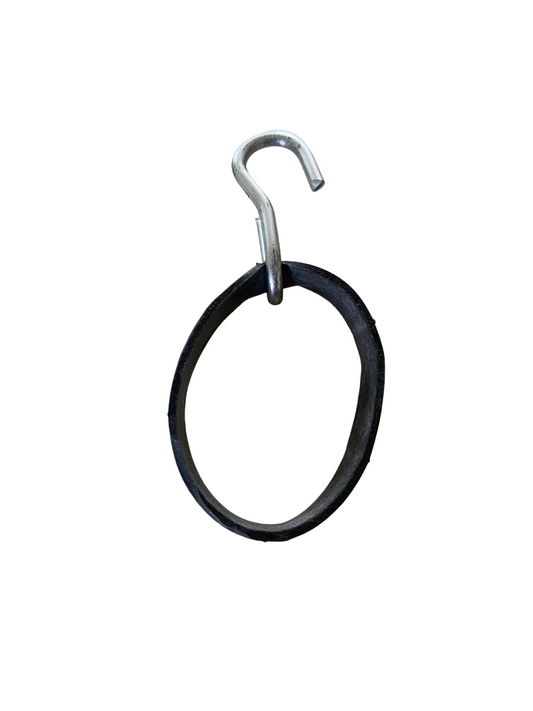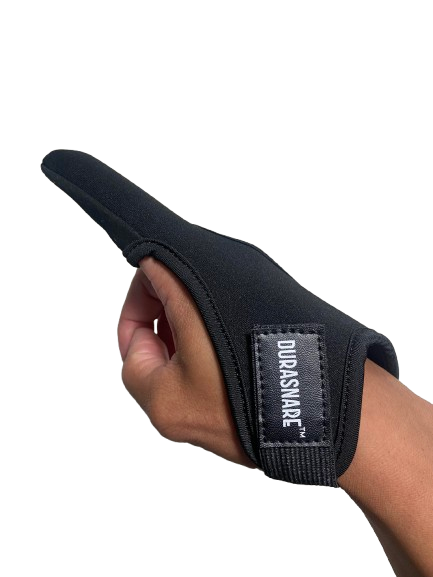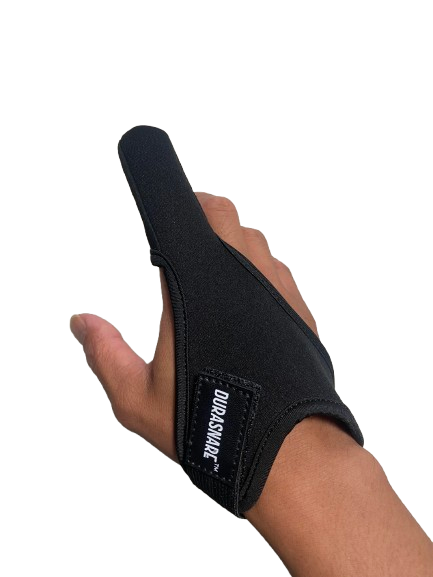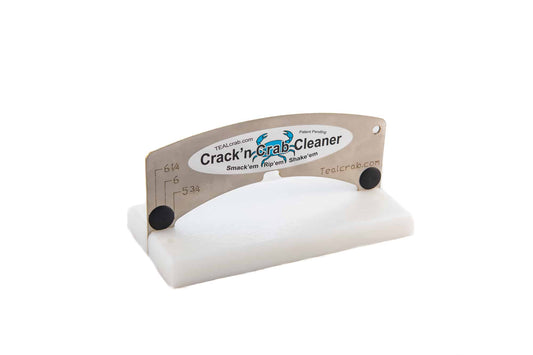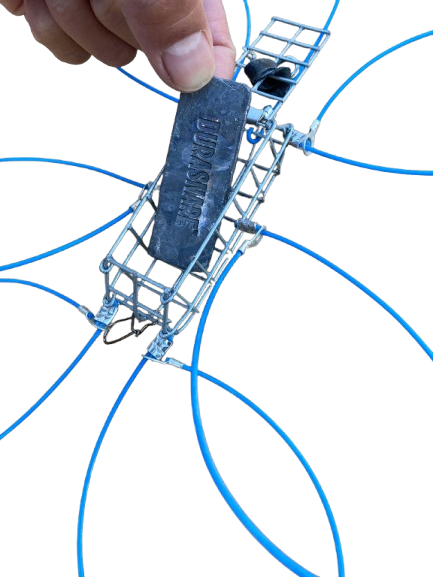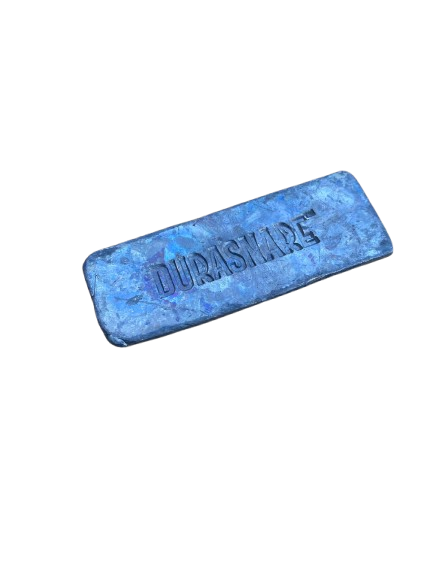CRAB SNARES
-
DURASNARE Galvanized Steel 8oz Blue Line Crab Snare
37 reviewsRegular price $20.00 USDRegular priceUnit price / per -
DURASNARE Vinyl Coated 8oz Blue Line Crab Snare
25 reviewsRegular price $20.00 USDRegular priceUnit price / per -
*NEW PRODUCT* DURASNARE Bait Efficient Galvanized Steel Crab Snare (8oz, 10oz, 12oz)
5 reviewsRegular price From $21.00 USDRegular priceUnit price / per -
*NEW PRODUCT* DURASNARE Bait Efficient Galvanized Steel Crab Snare Non-Weighted
No reviewsRegular price $18.00 USDRegular priceUnit price / per
ACCESSORIES
-
Upgraded replacement crab snare rubber band and hook assembly (pack of 3)
4 reviewsRegular price $3.00 USDRegular priceUnit price / per -
*NEW PRODUCT* DURASNARE Finger Casting Glove
2 reviewsRegular price $12.00 USDRegular priceUnit price / per -
Dungeness Crack’n Crab Cleaner
1 reviewRegular price $28.00 USDRegular priceUnit price / per -
DURASNARE 2oz drop-in lead weight
No reviewsRegular price $1.50 USDRegular priceUnit price / per$0.00 USDSale price $1.50 USD

Subscriber Giveaway
As a thank you to our supporters, we will be doing a subscriber giveaway. Three (3) winners will win a brand new PENN 650ssm reel, our new variation of 8oz bait efficient crab snare and finger casting glove. Giveaway ends December 31, 2024 at 11:59PM PST.
How To Enter:
1. Visit our YouTube channel: https://www.youtube.com/@Durasnare, hit the like button for your favorite video, leave a comment and MUST and Subscribe to our channel. Must be a real account and will be verified. One entry per person.
2. Sign up for our mailing list on the bottom of our website
3. Share this post and join if you haven’t already, join “Durasnare - All Things Crab” Facebook Page

Let customers speak for us
from 74 reviewsAwesome snares and great customer service! I bought one with the old style bands and it broke so I contacted them and they sent me two new packages of the updated rubber bands right away! I bought a few more durasnares and headed to the oregon coast, they worked great and brought in a few gauge busters!
Upgraded replacement crab snare rubber band and hook assembly (pack of 3)
I haven't had a chance to use them, but I can tell these are built to last for a long time.
Definitely one of the top tier snares I’ve used! Loops are always intact Durasnares are the way to go for crabbing!!Lawrence is also great with customer service and teaching with his YouTube vids!! Thank you Durasnare!!
I use a variety of snares when I go crabbing. But every time I go out and make sure one pole has a durasnare attached to it. It’s a great snare and the past five times I went out. I’ve always caught a keeper with it. Yes I’m a little lucky but it is a great product. Highly recommend.
Fast delivery and excellent customer care. Thanks
Tossed the 8oz when in estuary yesterday as the tide movement was calmer. Then hit surf to perch fish. No perch and the crabs were after my razor clam necks. Pulled out the 12oz but all I had were razor clam necks for bait. The snare gets emptied of those quickly, two casts max, sometimes just one. Had enough to fill snare once and I was able to pick up four to fill out limit with just one set of bait. Bait efficiently is an understatement. Still had 3/4’s of razor necks left in snare after hauling in a half dozen. These snares just keep getting better. And check out the new hook/clasp. Much easier to secure and unsecure.
Great snare. Best one I’ve used for durability. My wife and I always get our share and often out fish other fisherman!
I’ve been using a folding type snare for a few years now. I started off with an off brand cinch snare “like” the Durasnare and had terrible results. It was light and was carried away in current if you don’t add weight. The line and how the cinches were made was very poorly done. Never caught a single crab with it. Found a folding snare and it worked good, grabbed a lot of crab. Only thing it didn’t do was cast very well. I use a 13’ heavy action rod with an avet mxl conventional reel, one of my shore casting setups from back home on Maui. That setup likes around 8-10oz to cast well. So I had to add a bunch of weight to the folding snare to get any distance at all, but it still flew like a kite, got bucked around in the wind and liked to drift in the current. But it worked so that’s what I used…
Fast forward to thanksgiving weekend 2024. Camped on the Oregon coast at our usual crabbing spot. Brought out the casting rig and two casts in and my mainline snapped and I lost my folding snare. Pulled all the old line off my reel and drove up to the local tackle shop. Sarah was there and was quick to show me the Durasnare when I asked her what snares they had in stock. Given my past experience with cinch snares, I was very skeptical. But she insisted that these were flying off the shelves this season. So I bought me a spool of #40 mono an 8oz Durasnare and headed back to camp. First impression was “wow, this thing is made solid” and man can it cast!!! It flies into the wind like nobodies business and it can hold in current way better than the folding traps. My first cast ended up with a keeper crab and was getting good crab the rest of the afternoon.
Do yourself a favor. Buy one of these and go catch some crab!!!!!
I ordered 2 snare from you and rubber band and hook. I m not big fan of the folding trap. When I seen it on Brian channel automatic fishing. I ordered two I like the weighted trap, and I can pre cut my baits the night before
Durable and high quality! Love the finger protection but also how natural it feels wearing it while casting!!
Works great can't even feel the 80p braided line i use i love it
I went out to Charleston and gave it a try we landed four keepers in about 2 and 1/2 hours, it was really fun snare works great I recommend to anybody looking for a new hobby
I went out yesterday, Wednesday November 7th and crabbed from my inflatable kayak for 5 hours using my folding traps at Saltwater State park and caught three Red Rock. I decided to pack up and head up to the Des Moines Pier just mile north in Puget Sound. In two hours using these snares I caught two more Red Rock and two Dungeness. Also Lawrence from Durasnare happened to be at the pier on his PNW tour and is just a great guy providing bait for folks and tips on how to use these snares. Finally, snaring crabs is just a lot of fun. I am definitely recommending these snares to friends. Thanks to Durasnare for making such a great product! Crab on!
Frequently Asked Questions
How does a crab snare work?
A crab snare is a castable device which is used with a rod and reel to catch crab.
The crab snare is attached to the end of your main line to the leader line of your crab snare. You open up the lid of the crab snare, put your preferred bait in the middle and close the lid. You cast out into the body of water and wait about 5 minutes. When a crab finds the snare, it's legs are entangled or within one of the loops. When you reel up, the loops cinch down on the crabs legs acting like a sliding noose. By keeping constant tension from your reeling, the loops stay engaged on the crab's legs, snaring them up.
A crab snare is versatile where it allows you to crab in areas you typically are not able to access with a throwing net or traps unless you're on a boat/kayak. With a snare, you can cast from the shore, the jetty, the pier, docks, off the cliff and even off a boat.
Check out our YouTube which has Underwater Video of Durasnare in Action!
What type of gear do I need for crab snaring?
We recommend a 10-12ft surf rod medium to medium heavy rating. You want a sturdy rod because you’re tossing a weighted snare with bait which can get quite heavy and has a lot of load on the rod. A frequently used rod for crabbing is the Daiwa Beef Stick, Ugly Stick, or Okuma Crab Special. These rods are about $65-$75 price range. For the reel, use a good quality reel medium to large sized reel. When I first started crabbing, I used cheap reels that ended up stripping the gears, breaking the foot of the reel, the handle or cracking the housing. When you are reeling in, you are reeling in the weight of the crab snare, the bait, possibly multiple crabs, and fighting the current. This puts a lot of strain on the gears which result in putting more torque on the handles, overworking the gears, and friction on the foot of the reel which may snap. We recommend PENN brand reels such as Battles, Pursuits or SSMs. We personally use 650-750SSMs because they are full metal housing and interior gears. We can reel up 4 crabs at a time with no problem and will never strip the gears or break the foot of the reel.
For the line, you should use a minimum of 30-40lb monofilament line or 60-80lb of braided line. You are throwing very heavy weights so be sure you have adequate line to support the tension, otherwise you will end up snapping your line upon casting or retrieval.
Check out our YouTube Channel @Durasnare in the link below to learn more about gear recommendations.
How long do I leave my snare in the water before checking if there is a crab?
Typically you would leave the snare for about 5 minutes after casting. If there is no crab on the snare after checking, you can leave it in place for another 5 minutes. Do not leave the snare for more than 10 minutes at a time for crabs will clean out your bait box. Reel up completely to check for bait status. Check for indicators such as bites on your bait or an empty snare may mean there was crab in the area and had cleaned you out. Other indicators may be bait looking exactly the way you casted and have no bite marks at all. If there are no bites or change in your bait, move locations.
Your first and second casts will determine the frequency and timing of checking to see if you have crabs on the snare. You can have crabs on your snare in less than one minute after casting sometimes.
How do you know if there is a crab is on the snare? Is there a way of checking?
Crab snaring is different from fishing where you typically do not see or feel "nibbles" or "biting" where the tip of your rod bounces when a crab is on.
You can check to see if a crab is on your snare by slowly reeling up your slack and bring your rod up slowly towards you chest. If you feel a heavy weight like an anchor at the end of your line, more than likely you have a crab on your snare. If you bring your rod towards your chest and the snare slides along the bottom freely, you likely don't have a crab or you have been cleaned out of bait.
What type of bait should I use?
Frozen squid has been the preferred bait choice for crab snares. Squid takes longer to break apart by crabs and attracts crab very well. Using fish like mackerel, sardines, salmon or anchovies will work but they will dissolve a lot faster underwater. Alternatively, you can also use chicken as the base as a cheaper alternative and it does not break apart like squid or fish. For example, you can use a slice of chicken on the bottom of the snare, then add a squid or slices of fish on top as the main attractant. Crabs are bottom feeders and will eat just about anything.
We have found that fresh frozen bait works best when catching crab. There is no need to add additional scents or leave bait out to rot when using squid or fish. If you are using chicken only, then adding additional attractants can be beneficial. You can also buy a bottle of clam juice and soak chicken in it overnight in the fridge.
Commonly Used Bait:
- Squid
- Sardine
- Mackerel
- Herring
- Clams
- Tuna bloodline
- Shad
- Salmon scraps
- Rock Fish
- Chicken

